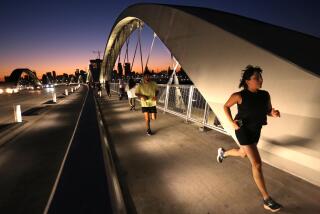Finding your footing
The never-ending quest to design a faster running shoe has led us to carbon-fiber pivot plates, clamshell foam-within-foam, customizable soles and even yak skin. Pronators to forefoot-landers will all find something here that is designed for them.
-- Roy M. Wallack
Yak attack
Ecco Biom: Minimally cushioned German-Danish yak-leather trainer for fast-paced runners that is designed to improve foot strength and speed over a six-week adaptation period.
Likes: A wide, airy forefoot of breathable yak lets toes spread out. A flat, light track-shoe profile, with the heel area rising just slightly (much less than the other test shoes), encourages a fast, smooth midfoot/forefoot foot strike, which over time has been proved to reduce injuries. Basically, this is a trainer for those who want to adopt more of a “barefoot running” style. Fancy zippered mesh box cover is included. There are two models -- Biom A for semi-pro to pro runners, and Biom B for fitness runners.
Dislikes: If you run too much, too fast, in the first couple of weeks, you may hurt your Achilles tendon and calves, which will not be adapted to the stretched-out, low-heel position. The harsher landings of the thin polyurethane midsole will bother cushioning junkies and die-hard heel-strikers; you must have a desire to switch to a forefoot landing. Also, despite the relative lack of padding, which makes it less comfy than the Nike, it inexplicably weighs no less. Ridiculously expensive.
Price: $220. (603) 537-7372; www.eccousa.com
Flying Finn
Karhu Strong Fulcrum Ride: Finnish-designed shoe with a built-in carbon-fiber plate/wedge that attempts to position a heel-striking foot so it rolls faster through its natural gait.
Likes: The theory is interesting: As your foot pivots over a wedge in the midfoot, vertical impact forces from the heel landing are better converted to forward motion. The heel-toe transition is accelerated and the body is launched forward for final push-off, making fast-paced runs get even faster. Reviewers from Runner’s World and Running Times agreed, the former naming the Fulcrum Ride “best new shoe of the year” in April. The 11.5-ounce (at size 9) shoe is designed for neutral runners (ones without big problems with pronation or supination).
Dislikes: It may not be so great for slow runners, midfoot/forefoot strikers, and those with D-width feet. The latter two refer to me, and I found the ride unnatural, the foot bed uncomfortable and my little toes severely cramped. Also, a growing number of runners think a heel strike should be avoided to start with, believing it leads to inefficiency and injury.
Price: $130. (978) 524-0032; www.karhu.com or www.craft-usa.com
Presto change-o
K-Swiss miSoul Tech: Trainer with two interchangeable insole/midsoles -- a light one for racing and a more cushioned one for training.
Likes: The concept, borrowed from K-Swiss’ successful tennis shoe line, uses two highly engineered, swappable insoles of different colors, which are viewable through clear plastic panels on the heel and on the sole. The white Light 1.0, featuring a thin, 8-inch insert of plastic on the inner side, is designed for high propulsion on race day; the blue Cushioning 1.0 has two large inserts of thick, red-colored gel pads in the forefoot and heel for long training runs. The cushioned model is quite roomy and comfortable; the racer feels faster.
Dislikes: The difference in weight between the soles is barely noticeable -- only a half-ounce. That still leaves the racer version (in size 9) at 12 ounces -- heavier than all the other shoes tested here.
Price: $125. (800) 938-8000; www.k-swiss.com
Tasty foam sandwich
Nike Lunar Glide+: Lightweight trainer with a newfangled two-part foam midsole that promises to be all things to all people: a stability shoe for those requiring extra support and a neutral cushioned shoe for those who don’t.
Likes: My feet felt pampered -- the shoe was cushy, comfortable, and balanced, with a subtle, energizing bounce. Instead of using Nike’s trademark Air midsole and a hard plastic post to keep the foot from excessively pronating (rolling to the inside through the gait), it uses a sandwich of firm foam around a soft foam core, which sits at an angle to control the foot. If your foot doesn’t need the control (mine doesn’t), the angle does not affect it. Also, it has a little-toe-friendly toe-box, even for Ds. Weight: 11 ounces in size 9.
Dislikes: None.
Price: $100. (800) 806-6453; www.nikestore.com
--
Roy M. Wallack is the author of “Run for Life” and the co-author of “Bike for Life: How to Ride to 100.”


